Anne Shileche
“Saying ‘Jambo’ and sharing the Kenyan Vibe at the UPEI Global Village”: Anne – Global Village
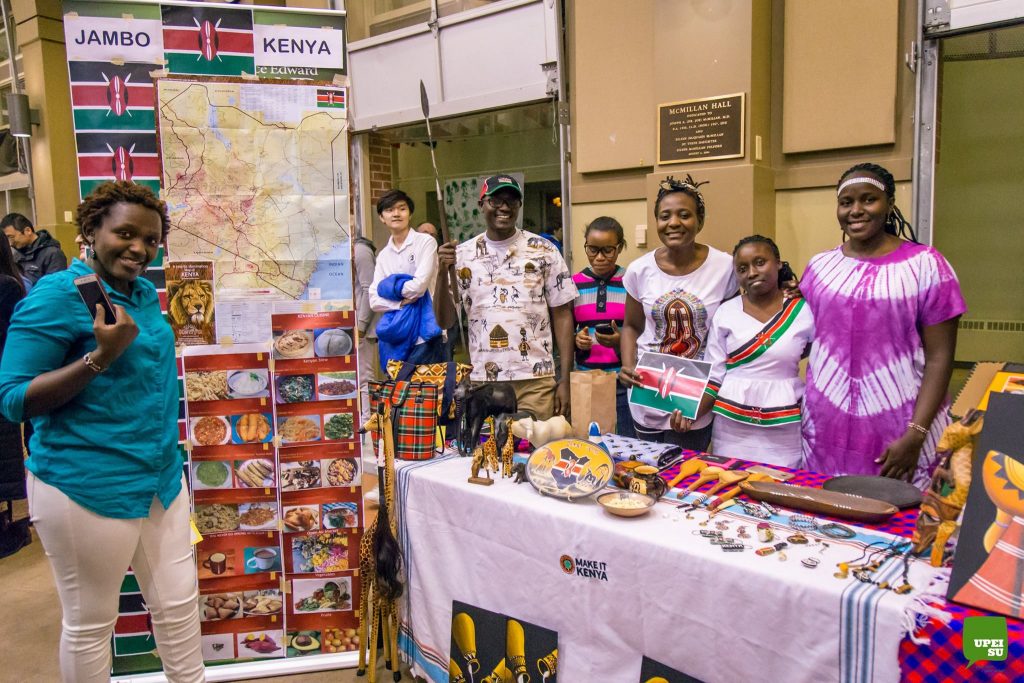
Kenyan team; from right, Peter, Dorcas, Anne, Grace and Sarah. Emily standing next to poster Credit: UPEI Student Union photographer Pravakar Thapa
To read about Anne’s trip to Ottawa, representing UPEI at a QES celebration. She met the Governor General of Canada, members of the QES funders, including the Community Foundations of Canada, Former Prime Minister of Canada, Jean Chretien, and other QES Scholars from other universities in Canada.Anne Shileche – Ottawa Blog
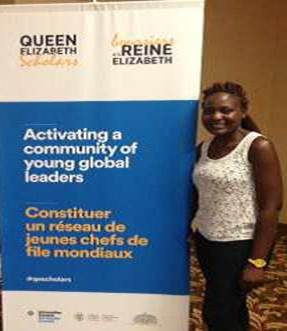
Get set and Go: The mood in Naari, Meru
My first visit to Naari was in summer of 2016. It didn’t surprise me that as a Kenyan, I had not been to this part of the country. Coming from the West of Kenya, I had not had a chance to visit the Meru region in Central Kenya. Fortunately, being part of the Queen Elizabeth Scholars (QES) project presented the opportunity to be in the locality. The thought of working and doing research in a new community was exciting. I am the kind of person who loves adventure, and I considered this as one. Though my last visit was short, it helped me familiarize with the community and the research project. This summer is now on a “get set and go” mode; a three month research work has begun.
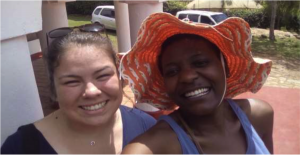
The QES project is having Kenyan and Canadian students deliver educational sessions in human nutrition and cattle management to small scale farmers in Naari community. My research is looking at the impact of these trainings on empowerment and civic engagement of participating group members. I will be going to visit selected participants in their homes to gather data. All the participants are women because a majority of small scale farmers in Naari area are women. My interests with empowerment and civic engagement are motivated by being a community development practitioner. From experience, I have seen people in Kenya organize themselves in social groups and use them as platforms for action within their communities. I am eager to find out whether this is the case in Naari community.
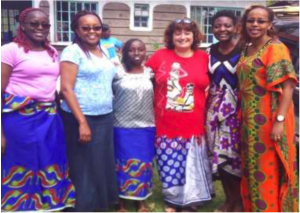
Planning dominated my first week; from pretesting of questionnaires, to training of a research assistant (translator) and selection of participants. I am scheduled to administer 60 survey questionnaires, 15 face-to-face interviews, and 3 focus group discussions. Two home visits are done. The study participants were kind enough to give me an hour of their time. From our side, we showed gratitude to the women by deworming their cows. My professor, who is a doctor of cows gave me a quick lesson on the process and left a fact sheet. There are 36 more cows to deworm. I am learning something new and beyond my profession. Only time will reveal whether there are more fascinating outcomes than deworming cows.

Out and About in the Naari community – July 7, 2017

I have spent the last one month traversing the Naari community in Meru. This place is both cold and hot; it depends on which location one stands. It is also rocky, and when we are in the car, mostly we are vibrating because of the rough and rugged terrain. I have learned some key Meru words to help with communication. But even with my efforts in pronunciation, my accent still sells me out. Nonetheless, I am awed at the warm hearts of the people in this community, they have been kind to let me into their homes and their lives. Some women have nick named me ‘Mwanamberi’ after I did a dance gig of the popular West Kenya song by the same name.
The majority of people in Naari are small-scale farmers, they keep dairy cows for milk and grow crops like maize, beans, Irish potatoes, and vegetables. The community has a dairy cooperative society which gives farmers a place to sell their milk. Naari Dairy Cooperative Society collaborates with partners like Farmers Helping Farmers and Queen Elizabeth Scholars to assist members with their farming ventures. Training in areas of agriculture, cattle management, and human nutrition is being offered to many farmers in the area. My movement within the community is to do with visiting selected farmers at the dairy, and finding out their perceptions on this training, how they are using it, and what is challenging or working for them.
In this picture, I am administering a survey to a woman who has received training on how to prepare and cook nutritious food. Survey questions range from demographic information, group organization and structure, self-confidence and community engagement. I am using a tool called Growth Empowerment Measure to help measure women’s emotional empowerment. The GEM tool was developed by Australian researchers led by Melissa Haswell. I am excited to pilot the GEM tool in Kenya.
My whereabouts in the community would be incomplete without taking the time to enjoy and appreciate some things like the sun, the food, and the smiles.
It took me experiencing a winter in Canada to appreciate the sun in Kenya. I am always happy to bask in it. I also enjoy the ripe avocados falling off Naari trees; this place is magical.
Lastly, my time in the field can never happen without Mary, my translator and Paul my driver, they tell me village stories which are hilarious. They have become my mama and papa.
Grace Wanjohi
Interactions with Joy and Upendo Women’s self-help groups
I am Grace Wanjohi, a Masters of Education student who is part of the 2017 nutrition team. It has been a great pleasure visiting women from both Joy and Upendo (‘love’) women’s self-help groups. Just as the names of the groups suggest, I have experienced amazing joy and love radiating from each woman I have visited. I have also seen the determination, hard work, self-sacrifice and resilience of an African woman through these women. Despite differences in age, socio-economic statuses, and education levels, just to mention but a few, the women in the two self-help groups are closely knit and admirably harmonious. Since my experiences with the women are so many to compress in one blog post, I highlight just a few of these encounters here.
The bumpy Naari roads led us to the homes of each woman from Upendo self-help group that we visited during the first week of fieldwork where we were assessing food security, diet quality, and nutrition knowledge, attitudes, and practices. These interviews are important to determine whether our nutrition and agricultural programming is working. I enjoyed Jen’s company during this week; I learnt a lot from her through her constant input during and after the interviews, as well as listened and laughed at her never-ending yet interesting stories. All women whom we visited welcomed us so warmly such that there was no problem building rapport with them. The warm welcome made the interview sessions run smoothly. One woman in particular (see photo below) would roll with laughter as we asked certain questions – her laughter seemed to be contagious.
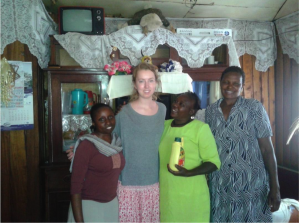
The home visits culminated in the peer-led nutrition education and cooking or ‘champs’ session. The food preparation team was enormous. It comprised of the thirty (30) women from the group, the nutrition team, Kenyatta University faculty as well as the Veterinarians without Borders. The morning session was characterized by a buzz of activities that yielded delicious and mouth-watering super uji (porridge enriched with milk and orange fleshed sweet potatoes), super githeri (maize and beans enriched with greens and carrots), and super mukimo (maize and beans mashed with irish potatoes, butternut, and stinging nettle)! The cooking session was a perfect way to practically demonstrating some nutrition messages such as increasing vegetable consumption by adding and green leafy vegetables and orange vegetables to local meals. Then came the dancing session that was irresistible to both young and old.

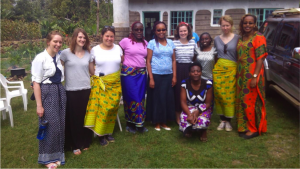
Like women from Upendo, women from Joy were equally so warm and welcoming. After every interview, each woman had something to offer us that we had to take home, despite our attempts to refuse to do so in some instances. The presents ranged from fruits, vegetables, eggs, tea, sugarcane, and live chickens, among many others.
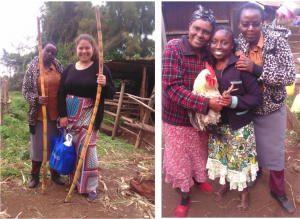
Other than the presents, we ate quite a number of delicious meals prepared by the women, mainly githeri and mukimo.
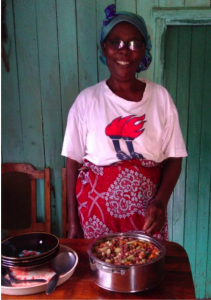
After the home-visits, we had a similar Champs nutrition session with the Joy Women’s group. We decided to ask the six Champs from the group to choose the meals to prepare for the peer-led session. Surprisingly, they choose the exact same meals that women from Upendo women had earlier prepared. They harmoniously shared out the various cooking tasks, which they performed swiftly and perfectly. We began by enjoying super uji prepared from two grains (mpempe and millet) with added milk and grated carrots. After an hour or so, the super githeri and mukimo was ready for serving. The meals was so delicious (In Kimeru they would say, ‘bithongi muno’) and nutritious. After the meals, we had the peer-led education session and then, song and dance followed.
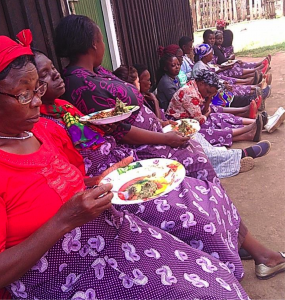
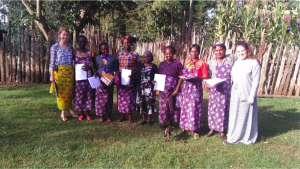
It has been great meeting and working with these two incredible women’s groups!
Sarah
Enhanced kitchen gardens are improving the diet diversity of women and families in Naari
Communities in Kenya are faced with different challenges. However, food insecurity and nutrition deficiencies have, over the years, been the most common problems affecting women and children in rural areas. Food insecurity exists when an individual or family lack access to sufficient quantities of safe and nutritious foods to be healthy and achieve their full potential. A lack of dietary variety, which is also common in the Naari area where we are working, often results in inadequate intakes of essential nutrients like iron, vitamin A, and zinc by women and children putting them at risk of poor health.

Kenya, like many other developing countries, has made slow progress in mitigating the effects of global warming, water scarcity and poverty, which are significant contributors to food insecurity and a lack of dietary diversity. Currently, the country is experiencing extreme climatic conditions. The prolonged dry spell has resulted in crop failures and escalating food prices especially that of Mpempe maize/corn which is the main staple. In particular, Naari area has received very little rain this spring, with similar trends in many parts of the country.
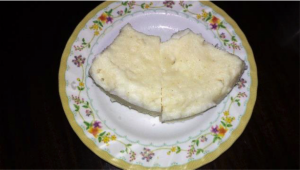
Farmers Helping Farmers (FHF), a non-governmental organization based in Prince Edward Island, has recognised the need to improve food security and has in the past thirty years partnered with different Women Self-help Groups in rural Kenya in order to improve their livelihoods. Currently, the organization is working with the Joy and Upendo Women Self-help Group’s in the Naari area in Meru County. The organization has provided water tanks drip pipes, quality vegetable seeds, as well as training on gardening, compost manure preparation, and pest control.
Despite the effects of global warming, water scarcity and high food prices in the country, families in Naari continue to thrive because of the assistance they have received from FHF. More women are now becoming proficient in vegetable and fruit production. This has in a great way empowered women smallholder farmers in this area to improve their families’ diets and overall livelihoods.
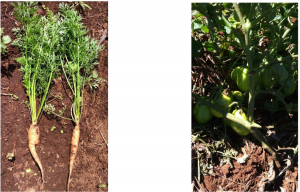
The provision of the enhanced kitchen gardens by FHF has made it possible for women smallholder farmers to provide a variety of healthy and nutritious vegetables to their families which add important diversity to the local starchy diets, which consist of dried maize and beans (with a higher ratio of maize), ugali (made from maize flour and water), rice and Irish potatoes.

A year after the introduction of drip irrigation to this area, a great deal has certainly changed in the women’s diets and it is clearly reflected by what the women are now planting in their gardens as well in their shambas (farms). There have been three major changes that I have noted over the course of the past year.

First, more women in the community are now more engaged in the gardening of vegetables and fruits than before. The periodic visits by the FHF horticulturist, Stephen Mwenda, have increased their yields. Most women are now planning on how they can expand their garden sizes to double their production (below are some yummy vegetables and fruits that are doing so well in this area).
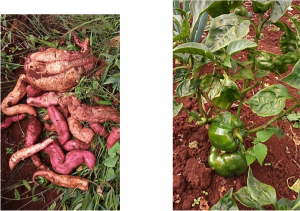
Second, the drip irrigation technology provided by FHF has reduced overdependence on rain fed agricultural production thereby enabling women smallholder farmers to produce a wide range of healthy and nutritious vegetables for their families all year round. The initiation of drip irrigation and horticultural training into this area, has made it possible to introduce a variety of new nutritious drought resistant crops in this area. A good example of this is the orange fleshed sweet potatoes (a good source of Vitamin A).

The third change that I have seen in the past weeks as a result of drip irrigation technology is that the women’s diet diversity has increased correspondingly with the greater crop variety in their shambas. I have been assessing food security and dietary diversity among Upendo and Joy Women’s group members and these encounters have been full of surprises. I continue to discover new varieties of nutritious vegetables and fruits in the women’s diets. More families are growing and consuming a wider range of highly nutritious green and orange vegetables and fruits than they did before they had the drip irrigation technology or the enhanced kitchen gardens. Examples of these new crops/dishes are squash, carrots, tomatoes, kale, spinach, pumpkin leaves, and stinging nettle among others.


According to Stephen Mwenda (a horticulturist working for FHF), the combined training in gardening and appropriate food preparation techniques have also made women more aware of the importance of integrated agriculture, as well as the nutritional value of different crops in their gardens.
As a result of the acquired agricultural skills and nutritional knowledge, more women are now to attend agricultural field days, agricultural fair, and other agricultural symposiums than in the past. It is during these events that they get sprouted fruit seedlings which they then plant in their farms. This has promoted the consumption of different varieties of fruits and vegetables in this area. Examples of these fruits include guavas, oranges, apples, watermelons, and pomegranates which are now widely grown in this area.
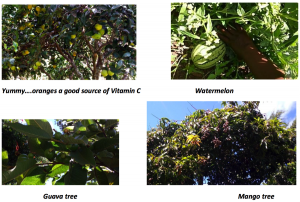
This increase in crop diversity in Naari clearly shows what women can grow when they have access to water all year round!
